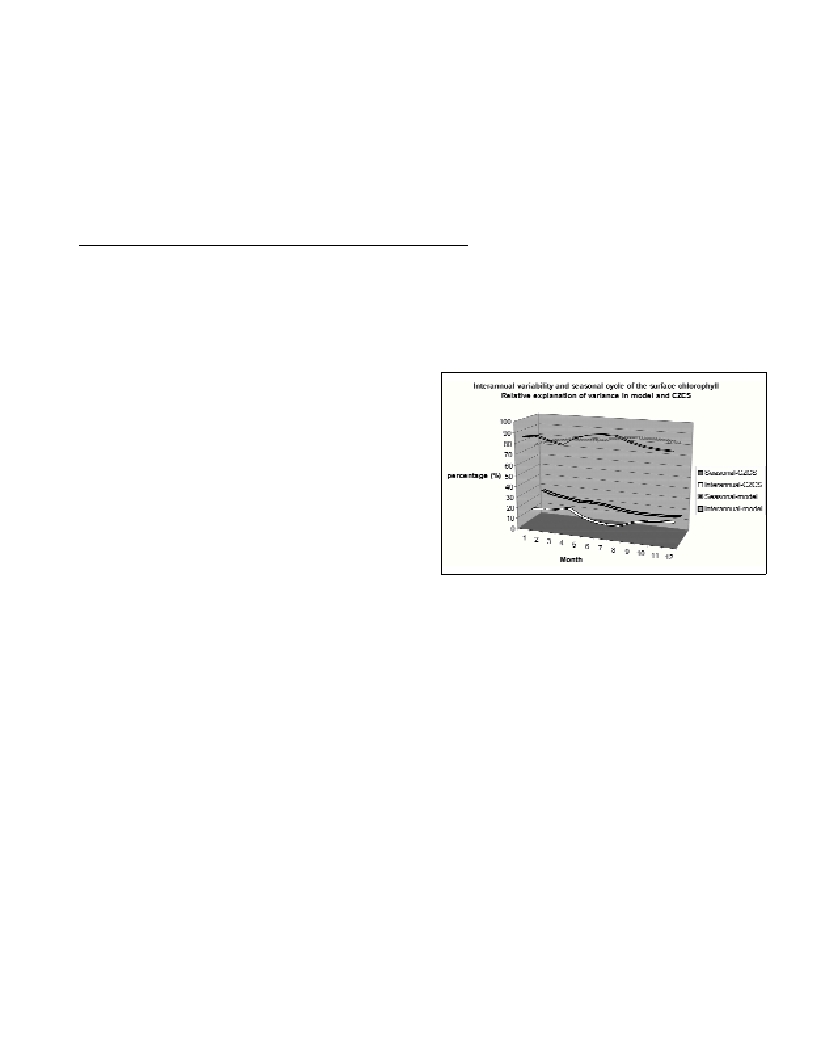A COMBINED APPROACH TO STUDY INTERANNUAL VARIABILITY OF PIGMENTS
IN THE FIRST OPTICAL LENGTH IN MEDITERRANEAN SEA
Alessandro Crise*, Guido Crispi, Valentina Mosetti
Department of Oceanography, Istituto Nazionale di Oceanografia e di Geofisica Sperimentale, Borgo Grotta Gigante 42/c,
34010 Sgonico (TS), Italy .
Abstract
The aim of this work is to provide evidence of the interannual variability of the pigments in the upper ocean up to the first optical length.
The approach is twofold: a 3D eco-hydrodynamical model describing the nitrogen cycle in the Mediterranean Sea has been integrated for
the period 1980-86 to obtain estimates of monthly mean chlorophyll concentrations. Seasonal cycles are computed both from model results
and CZCS monthly means obtained from JRC. The analysis of normalized relative anomalies show that in both cases the seasonal signal
usually accounts for more than 80% of the energy of total signal.
Keywords: nitrogen cycle, interannual variability, chlorophyll content, CZCS.
Rapp. Comm. int. Mer Médit., 37,2004
184
Introduction
The interannual-to-decadal variability of circulation of upper and
intermediate layer over the Mediterranean Sea has been appraised by
many authors.Variability studies of the pelagic biogeochemical
cycles on multiannual scales is instead hampered by the scarcity of the
data sets. These studies are mainly located in selected areas such as
the NW Mediterranean [1]. Here a coupled eco-hydrodynamical
model is used to capture a basin-wide multiannual variability in the
Mediterranean Sea. An estimate of relative importance of interannual
variability versus seasonal cycle for the chorophyll content in the first
optical length in Mediterranean area. Independently, the same
estimates are obtained from the analysis of pigments concentration as
derived by CZCS images. The comparison of satellite images with the
model diagnosed chlorophyll fields demonstrates the robustness of the
estimates.
Materials and methods: model experiments and remotely sen-
sed chlorophyll concentration field processing.
Here the model protocol is firstly presented, and then the analysis
of chorophyll concentration as derived from CZCS optical sensor.
The model is composed by two modules: a 1/4 degreee 31 level
MOM 1.0 OGCM plus Nitrogen-Phytoplankton-Detritus-Chlorophyll
(NPD-Chl) nitrogen cycle described through a set of advection-
diffusion-reaction non-linear equations. Details on the functional
forms of the equations, parametrization, numerics and forcings of the
coupled model are provided in [2,3].
The model is in this case forced with NMC/NCEP annually varying
monthly means along the period 1980-86. Chlorophyll-a was
diagnostically computed from model outputs using an empirical non-
linear model [4].The pheopigments concentration (ugChl/dm
3
) in the
first optical length was detected by CZCS sensor in the period 1979-
1985. The original data set used here, reanalyzed by EU Joint
Research Center of Ispra, was converted and regridded to a 2kmx2km
resolution. A bathymetric mask was applied to regions shallower than
200m to wipe out coastal signals from the pelagic region both in
model outputs and images.
Results
To obtain a synthetic estimate of the relative importance of
interannual variability, the Hovmoller diagram of meridionally
integrated (between 30.5N and 45N) chlorophyll fields are computed
from both model and images. In this way, the well known zonal
trophic gradient (presentet also in chlorophyll concentration), is
preserved.
Both model and images show that the response of the basin is
locked to the seasonal cycle all over the Mediterranean except for
Alboran Sea which seems instead controlled by permanent upwelling
conditions combined with baroclinic dynamics. The clear west-to-east
negative gradient in chlorophyll concentration indicates the averaged
increasing oligotrophy of the surface waters. Permanent maxima are
connected to subbasin scale circulation, more evident in the western
areas. Weaker signals are evident in the Eastern Mediterranean where
the fertilization effects of Rhodes Gyre are barely visible at surface.
Chlorophyll content shows energetic maxima in 1981 and 1983 years
in Western Mediterranean. The model exibits stronger relative
variability in the Eastern Mediterranean where winter maxima appear
overestimated. Seasonal anomalies found in the Western
Mediterranean during Autumn 1981 and 1982 are present both in
images and model outputs (but not 1982 winter anomaly) as well as
the 1983 winter peak (more spread in the CZCS). Summer deep
chlorophyll maxima (in particular in the eastern basin) are too deep to
be capture by satellite images but are well represented by the model.
The explanation of the normalized variance of the signal integrated
over the East and West Mediterranean Sea is shown in Fig. 1: the
seasonal cycle explains about 80% of the variance, except for January
where the model only predicts slightly higher variability.
Interestingly, similar figures were obtained in East Mediterranean
from an EOF analysis of SST diagnosed from AVHRR radiometer [5].
Fig.1. Breakdown of normalized chlorophyll variance expressed in terms
of seasonal and interannual variability along the climatological year cal-
culated in the period 1980-86. CZCS results are shaded while model out-
puts are plotted with thicker lines.
Acknowledgments. This research is partially funded by the project
SINAPSI in the frame of Italian CNR Program ‘Ecosistemi marini’.
References
1-Marty J.-C. (ed.) 2002. Studies at the DYFAMED (French-JGOFS)
Time-Series Station, N.W. Mediterranean Sea. Deep-Sea Res. II, 49: 11,
1963-2192.
2-Crise A. , Crispi G. and Mauri E., 1998. A seasonal three-dimensional
study of the nitrogen cycle in the Mediterranean Sea. Part I. Model
implementation and numerical results, J. Mar. Systems.,18, 1-3: 287-312.
3-Crispi G., Crise A. and Mauri E., 1999. A seasonal three-dimensional
study of the nitrogen cycle in the Mediterranean Sea. Part II. Verification
of the energy constrained trophic model. J. Mar. Systems., 20, 1-4: 357-
380.
4-Cloern J.E., Grenz C. and Vidergar-Lucas L., 1995. An empirical
model of the phytoplankton chlorophyll:carbon ratio – the conversion
factor between productivity and growth rate. Limnol. Oceanogr., 40, 7:
1313-1321.
5-Marullo, S., R. Santoleri, P. Malanotte-Rizzoli and Bergamasco A.,
1999. The sea surface temperature field in the Eastern Mediterranean from
advanced very high resolution radiometer [AVHRR] data Part II.
Interannual variability, J. Mar. Systems, 20: 83-112.

